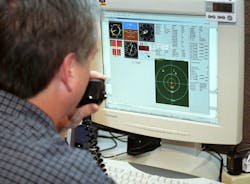Wanted: bandwidth-efficient data communications to help battlefield commanders rank targets in real time
AUSTIN, Texas – U.S. Army researchers are approaching industry for low-latency and bandwidth-efficient data transport to help move visual information from the battlefield's edge to commanders detect and rank targets.
Officials of the Army Applications Laboratory (AAL) in Austin, Texas, issued a broad agency announcement (W911NF-25-S-A2V2) on Wednesday for disruptive technologies related to accelerated and automated visual verification (A2V2).
Researchers are looking for the ability to extract the most critical information from video feeds in real time, and transmit a combination of compressed imagery and targeting data communications to command centers. This technology should improve bandwidth usage and reduce the size of transmitted data.
Real-time video
Real-time video of potential targets today typically comes from uncrewed vehicles, where it is stored on uncrewed vehicle control stations. Transmitting that data to commanders requires a significant amount of network bandwidth that is not available in a complex, contested environment, delaying targeting.
Instead, Army researchers seek the ability to gather and transmit photos and video in contested environments in real time enhances battlefield situational awareness, timely decision-making, and mitigates the risks of target misidentification and fratricide.
Among the enabling technologies the Army would like to develop are the ability to accept real-time video from standard military sources like HDMI and SDI; encoding and processing video in real-time aboard unmanned vehicles using embedded computing graphics processing units; support for visible and infrared video streams; enabling operators to specify target priority lists; differentiate between priority targets; transmitting only necessary imagery for visual verification; support for tactical radio or LTE/5G backhaul with minimal bandwidth consumption; portable ruggedized hardware; wide access to power from batteries and vehicle power systems; encryption; and simultaneous video streaming and object detection.
Related: Army tactical communications driven by bandwidth, security demands
Companies interested should email white papers no later than 2 June 2025 to [email protected], with A2V2 Special Notice in the subject line. White papers should relate to full motion video; aided target recognition; data prioritization; data size reduction; low-bandwidth data dissemination; and data analytics at the near-edge.
Those submitting promising white papers may be invited to submit full proposals. Total money available for the project is $6 million.
Email questions and concerns to the Army's Maj. Rickey Royal at [email protected]; Molly Thomson at [email protected]; and Rodolfo Estrada at [email protected].
About the Author
John Keller
Editor-in-Chief
John Keller is the Editor-in-Chief, Military & Aerospace Electronics Magazine--provides extensive coverage and analysis of enabling electronics and optoelectronic technologies in military, space and commercial aviation applications. John has been a member of the Military & Aerospace Electronics staff since 1989 and chief editor since 1995.
